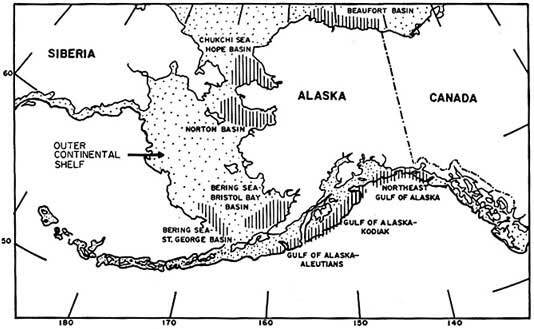
Outer Continental Shelf Study
What do we need to know about Alaska's outer continental shelf prior to the development of this petroleum-rich region? This problem faced the Bureau of Land Management, the federal agency charged with the responsibility for a multiyear program of environmental assessment of the shelf. The BLM contracted with another federal agency, the National Oceanic and Atmospheric Administration (NOAA), to review proposals presented by scientists of several disciplines and to direct the program.
The abundant stocks of marine mammals in Alaskan waters concerned a number of biologists. Among these mammals being studied are the Pacific walrus, bowhead and beluga whales, harbor seals, bearded seals, ringed seals, spotted seals, sea otters and Steller sea lions. Scientists are investigating the seasonal distribution, mortality, numbers, and biology of the mammals from the Beaufort Sea to the Gulf of Alaska.
Additionally, biologists are looking at marine birds of the Outer Continental Shelf. The distribution, abundance, and feeding ecology of the Arctic and Bering Sea birds, their relationship to the pack ice, and the probable impact of petroleum development must be determined.
Fish and the organisms upon which they feed are of great importance. Several scientists are seeking to determine the abundance of plankton in the Gulf of Alaska and elsewhere along the shelf. Others are examining the distribution, abundance, diversity, and productivity of bottom-dwelling organisms off the Alaskan coast.
Experiments have been undertaken to assess the effect of contaminants on fishes, pinnipeds, herring, roe, crabs, and marine organisms. Obviously the contaminant of chief interest and concern is petroleum. Basic studies of water conditions are also crucial to the contamination dangers. Chemists and microbiologists are making hydrocarbon analyses of the sea-ice-water interface and observing the distribution of light hydrocarbon and that of trace heavy metals.
Physical oceanography is still another area of research. Surface currents, the transport of pollutants, marine climatology, atmospheric modification, and the seasonability and variability of streamflow into the ocean represent just a sampling of the oceanographic projects.
Geologists are looking at seismic and volcanic hazards in the Aleutians and sedimentation and morphology along the entire shelf. The effect of offshore permafrost drilling on the environment is one major study, and the incidence of coastal erosion is another.
Finally, scientists at the University of Alaska's Geophysical Institute and other research units are focusing upon the characteristics of sea ice in the Beaufort Sea, Chukchi Sea, Bering Strait, and Bering Sea. Climatic effects on fast ice, mechanics of origin and pressure ridges, and the dynamics of near- shore ice occupy the attention of a number of scientists. Ice conditions have a history just as any other natural phenomena and University of Alaska historians are tracing past activity through the logs of whaling and other vessels for the last 100 years.
Taken all together, the Outer Continental Shelf environmental assessment, which is now going into its second year, is a practical demonstration of the importance of a concerted, interdisciplinary approach to an understanding of our natural environment.





